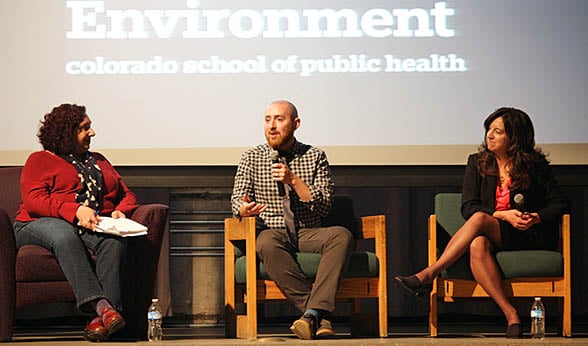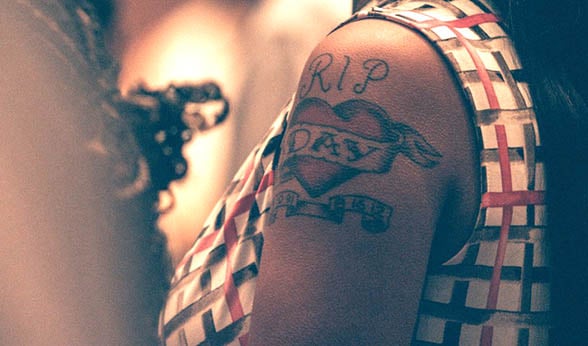An hour and a half into his first day on the first job of his life, 21-year-old Lawrence Daquan “Day” Davis was killed.
The story of his untimely death is the focus of the award-winning film, “A Day’s Work,” screened recently at an event hosted by the Colorado School of Public Health’s Center for Health, Work & Environment.
 At the film screening are, from left, Sarah Shikes, Executive Director, El Centro Humanitario; David DeSario, Producer, “A Day’s Work”; and Chris Lorenzo, Safety and Occupational Health Manager, Occupational Safety and Health Administration (OSHA).
At the film screening are, from left, Sarah Shikes, Executive Director, El Centro Humanitario; David DeSario, Producer, “A Day’s Work”; and Chris Lorenzo, Safety and Occupational Health Manager, Occupational Safety and Health Administration (OSHA).
Day Davis reported for work at a Bacardi bottling plant in Jacksonville, Fla., on Aug. 16, 2012. Looking proud in a bright orange vest and protective eyeglasses, Davis posed for a selfie in the bathroom mirror and texted his girlfriend. Later, as Davis cleaned up broken glass under a palletizer, a machine used to pack and stack products, another worker turned the machine on. The palletizer pushed cases down the conveyor belt, then onto the pallet below. That was when workers nearby heard a yell.
First responders arrived minutes later. But it was too late. Davis was already dead. He was crushed under 60 cases of bottles, weighing roughly 2,000 pounds.
Trend Towards Temp and Greater Risk
Increasingly, employers are outsourcing work to temporary workers, freelancers, and other contractors. A 2015 report by the Government Accountability Office found that 40 percent of the workforce in 2010 had “alternative work arrangements.” This percentage included company and independent contractors and on-call, temporary, self-employed, and standard part-time workers. And these numbers are growing.
Sadly, this means more workers are at greater risk of being injured, or even killed, on the job. Temporary workers are at least twice as likely to be injured at work compared to permanent employees, according to a 2013 ProPublica analysis.
“Research shows that temp workers are often overlooked when it comes to being adequately trained on how to do their jobs safely. They are falling through the cracks,” said Lee Newman, MD, ColoradoSPH professor and director of the Center for Health, Work & Environment on the CU Anschutz Campus.
 A scene from the film 'A Day's Work.'
A scene from the film 'A Day's Work.'
A former temporary worker himself, the producer of “A Day’s Work,” David DeSario, cites fear of retribution as one reason why temporary workers face higher risk.
“If a temp worker speaks up about a safety or health concern, they might not be working there the next day. Their jobs are vulnerable. They need people in the safety and health community and they need a voice through worker-run organizations,” DeSario explained.
Valuing Safety
DeSario’s film is a sobering reminder of the human cost of employer safety violations and serves as a call to action.
“The joy of this film is going back and telling Day’s family all the groups they have been able to reach,” said DeSario. “This film is about reaching people who work in public health. People who work on the ground every day and have the power to influence what’s happening out there.”
Experts at the Center for Health, Work & Environment are researching the best ways to keep workers safe and healthy, even as the employer-employee relationship changes.
“There is mounting evidence that there is a good business case for promoting healthier and safer workplaces,” Newman said. “In our ongoing research, we are establishing and testing best practices that can be readily adopted, even by small businesses, to create a happier, more engaged, and more productive workforce.”
One way to make a difference, for temporary and permanent workers alike, is to encourage employers to create a company culture where safety is a core value.
“Companies have to follow regulations and policies, but their workforce also needs to feel supported. They need to feel like the place they work, their managers, and their co-workers have their back in every instance. That is why culture is important,” said Natalie Schwatka, PhD, AEP, a researcher at the center and instructor at the Colorado School of Public Health. “Safety culture is about the employee’s perception of how much their employer values them and cares about their safety.”
Making a sound business case for why employers should invest in the health and safety of their employees can be challenging, especially for employers who rely on a temporary or contract workforce. But researchers at the Center for Health, Work & Environment see an opportunity to make a case for return on investment.
“Employers should care about all of their workers. Any safety incident results in lost productivity and damage to product, regardless of the status of the worker involved,” said Schwatka.
To learn more about the Center for Health, Work & Environment’s work and other upcoming events like their recent screening, visit chwe.ucdenver.edu.
Guest contributor: Avery Artman, communications and media coordinator, Center for Health, Work & Environment, Colorado School of Public Health.
